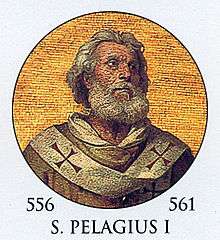Pope Pelagius I
| Pope Pelagius I | |
|---|---|
 | |
| Papacy began | 16 April 556 |
| Papacy ended | 4 March 561 |
| Predecessor | Vigilius |
| Successor | John III |
| Personal details | |
| Birth name | Pelagius |
| Born | Rome, Ostrogothic Kingdom |
| Died |
4 March 561 (aged 61) Rome, Eastern Roman Empire |
| Other popes named Pelagius | |
Pope Pelagius I (d. 4 March 561) was Pope from 556 to his death in 561. He was the second pope of the Byzantine Papacy, and like his predecessor, a former apocrisiarius to Constantinople.
Early life
He came from a Roman noble family. His father John seems to have been vicar of one of the two civil "dioceses", or districts, into which Italy was then divided.[1]
Apokrisiariat
Pelagius accompanied Pope Agapetus I to Constantinople and was appointed by him nuncio of the Roman Church to that city. Pelagius acquired great influence with Justinian, and returned to Rome in 543.[1]
In 545, when Pope Vigilius went to Constantinople on the orders of Emperor Justinian I, Pelagius stayed in Rome as the pope's representative. Totila, King of the Goths, had begun to blockade the city. Pelagius poured out his own fortune for the benefit of the famine-stricken people, and tried to induce the king to grant a truce. Though he failed, he afterwards induced Totila to spare the lives of the people when he captured Rome in December 546. Totila sent Pelagius to Constantinople in order to arrange a peace with Justinian I, but the emperor sent him back to say that his general Belisarius was in command in Italy.[1]
Papacy
Pelagius was elected Pope as Justinian's candidate, a designation not well received by the western clergy and laity.[2] While before his ordination he opposed Justinian's efforts to condemn the "Three Chapters" in order to reconcile theological factions in the Church, afterwards Pelagius adopted Justinian's position.
Rumors that he might have somehow been complicit in the death of Virgilius, and suspicion that his conceding to Justinian indicating a support for Monophysitism undermined his papacy. To overcome this he worked to maintain public order in Rome, and correct abuses among the clergy. He also labored on behalf of the poor and the victims of famine and war. In response to a request from the garrison commander at Civitavecchia, Pelagius directed Bishop Lawrence of that town, to provide chaplains for the army.[3] He is credited with the construction of the Santi Apostoli, Rome,[4] built to celebrate the complete victory of Narses over the Ostrogoths.
The elderly pope served five years, and upon his death was buried in St. Peter's.[2]
See also
Notes
- 1 2 3

- 1 2 Brusher, Joseph S., Popes Through the Ages, 1980, San Rafael, California, Neff-Kane, ISBN 978-0-89-141110-9
- ↑ Bachrach, David Steward. Religion and the Conduct of War, C. 300-1215, Boydell Press, 2003, ISBN 9780851159447, p. 17
- ↑ "Santi XII Apostoli", Pontifical North American College
References
- Ekonomou, Andrew J. 2007. Byzantine Rome and the Greek Popes: Eastern influences on Rome and the papacy from Gregory the Great to Zacharias, A.D. 590–752. Lexington Books.
| Wikimedia Commons has media related to Pelagius I. |
| Catholic Church titles | ||
|---|---|---|
| Preceded by Vigilius |
Pope 556–561 |
Succeeded by John III |

